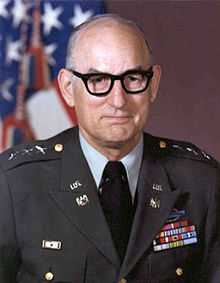La Vern E. Weber
| La Vern E. Weber | |
|---|---|
 Lieutenant General La Vern E. Weber as National Guard Bureau Chief | |
| Born |
September 23, 1923 Lone Wolf, Oklahoma |
| Died |
December 30, 1999 (aged 76) Perry, Oklahoma |
| Allegiance | United States of America |
| Service/branch | United States Army |
| Years of service | 1942–1984 |
| Rank | Lieutenant General |
| Unit |
Oklahoma National Guard National Guard Bureau |
| Commands held |
Oklahoma National Guard Army National Guard National Guard Bureau |
| Battles/wars |
World War II Korean War |
| Awards |
Distinguished Service Medal (U.S. Army) Air Force Distinguished Service Medal Legion of Merit |
| Other work | Executive Director, National Guard Association of the United States, 1984-1993 |
La Vern E. Weber (September 3, 1923 – December 30, 1999) was a United States Army officer who served as Adjutant General of Oklahoma, Director of the Army National Guard and Chief of the National Guard Bureau. He was the first NGB Chief to hold the rank of Lieutenant General.[1]
Early life
La Vern Erick Weber was born in Lone Wolf, Oklahoma on September 3, 1923. He attended the University of Oklahoma and Louisiana Tech University, where he played football before leaving in 1942 to enlist for World War II.[2] Originally part of the Navy’s V-12 program,[3] he received a commission in the Marine Corps upon completing Officer Candidate School in 1945. He served in the Marine Corps Reserve until 1948.[4] He also graduated from Oklahoma's East Central State College (now East Central University) with a bachelor of science degree in education in 1948, and then joined the Oklahoma National Guard as a Second Lieutenant. In addition to maintaining a farm, he also worked as a teacher and coach.[5]
Korean War
He was mobilized in 1950 with the 45th Infantry Division for the Korean War. Weber served as Operations and Training Officer (S3) of 2nd Battalion, 180th Infantry Regiment.[6]
Post Korean War
Weber returned to Oklahoma in 1952 and was assigned as Operations and Training Officer for the 179th Infantry Regiment. In 1955 he graduated from the United States Army Command and General Staff College and was assigned as Intelligence Officer (G2) of the 45th Infantry Division.[7]
In 1961 Weber became the 45th Division’s Personnel Staff Officer (G1), and in 1964 he was appointed division Chief of Staff, receiving promotion to Colonel.[8] In 1965 Weber was appointed Adjutant General by Governor Henry Bellmon and promoted to Brigadier General and then Major General.[9]
National Guard Bureau
In 1971 Weber was appointed Director of the Army National Guard.[10]
In 1974 he was appointed Chief of the National Guard Bureau, and Charles A. Ott, Jr. succeeded Weber as Director of the Army National Guard.[11] In 1979 he was promoted to Lieutenant General.[12]
FORSCOM
Weber served as Deputy Commander for Mobilization and Readiness at United States Army Forces Command (FORSCOM) and Executive Officer of the Reserve Forces Policy Board (RFPB) from 1982 until retiring in 1984.[13]
Awards and decorations
Weber’s awards included the Army Distinguished Service Medal, Air Force Distinguished Service Medal, Legion of Merit and Combat Infantryman Badge.[14]
Post military career
After retiring from the military Weber was appointed Executive Director of the National Guard Association of the United States, and he served until 1993.[15]
Retirement and death
In retirement Weber lived on a farm near Perry, Oklahoma. He died there on December 30, 1999 as the result of injuries sustained when fence panels he was preparing to install fell on him.[16]
Weber was buried in the Oklahoma Veterans Cemetery in Oklahoma City.[17]
Legacy
The National Guard Professional Education Center (NGPEC) at Camp Joseph T. Robinson, Arkansas is named for him.[18]
References
- ↑ U.S. House Appropriations Committee, Defense Appropriations Subcommittee, Biographical sketch, La Vern E. Weber, 1985, page 646
- ↑ Office of Public Affairs, National Guard Bureau, General officers of the Army and Air National Guard, Volume 1, 1972, entry for La Vern E. Weber]
- ↑ Wesley Harris and Malcolm Butler, Louisiana Tech Sports, 1944: Navy Sails to Tech's Rescue: V-12 program helps Bulldog program, Sept. 21, 2010
- ↑ United States House of Representatives Armed Services Committee, Biographical sketch, La Vern E. Weber, 1981, page 360
- ↑ National Guard Association of the United States, The National Guardsman magazine, Volumes 28-29, 1974, page 9
- ↑ U.S. House Appropriations Committee, Subcommittee on Defense Appropriations, Biographical sketch, La Vern E. Weber, 1985, page 646
- ↑ United States House of Representatives Armed Services Committee, Biographical sketch, La Vern E. Weber, 1974, page 604
- ↑ National Guard Association of the United States, Official Proceedings, Volumes 93-96, 1971, page 50
- ↑ U.S. House of Representatives Appropriations Committee, Biographical sketch, La Vern E. Weber, 1978, page 591
- ↑ Association of the United States Army,Army magazine, Volume 24, 1974, page 66
- ↑ Braddock Publications, The Executive Bio-pictorial Directory, 1981, page 68
- ↑ National Guard Association of the United States, Official proceedings, 1979, page 51
- ↑ Denise Gamino, The Oklahoman, Reagan Chooses Sooner for Post, August 13, 1982
- ↑ Billy R. Wood, Lords of Darkness: A History of the 45th Aviation Battalion (Special Operations) and Oklahoma Army National Guard Aviation, 2011, page 98
- ↑ Congressional Record, Extension of Remarks: Tribute to Lieutenant General (retired) La Vern E. Weber, Rep. Ernest Istook, January 27, 2000
- ↑ The Oklahoman, Guard's Ex-Leader Dies in Accident, December 31, 1999
- ↑ The Oklahoman, Thunderbird, At Rest, January 18, 2000
- ↑ National Guard Professional Education Center, Home Page, accessed April 10, 2013
External resources
- Oklahoma Historical Society, Encyclopedia of Oklahoma History & Culture, Weber, La Vern Erick, accessed April 10, 2013
- La Vern E. Weber at Find A Grave
| Military offices | ||
|---|---|---|
| Preceded by Francis Greenlief |
Chief of the National Guard Bureau 1974-1982 |
Succeeded by Emmett H. Walker, Jr. |